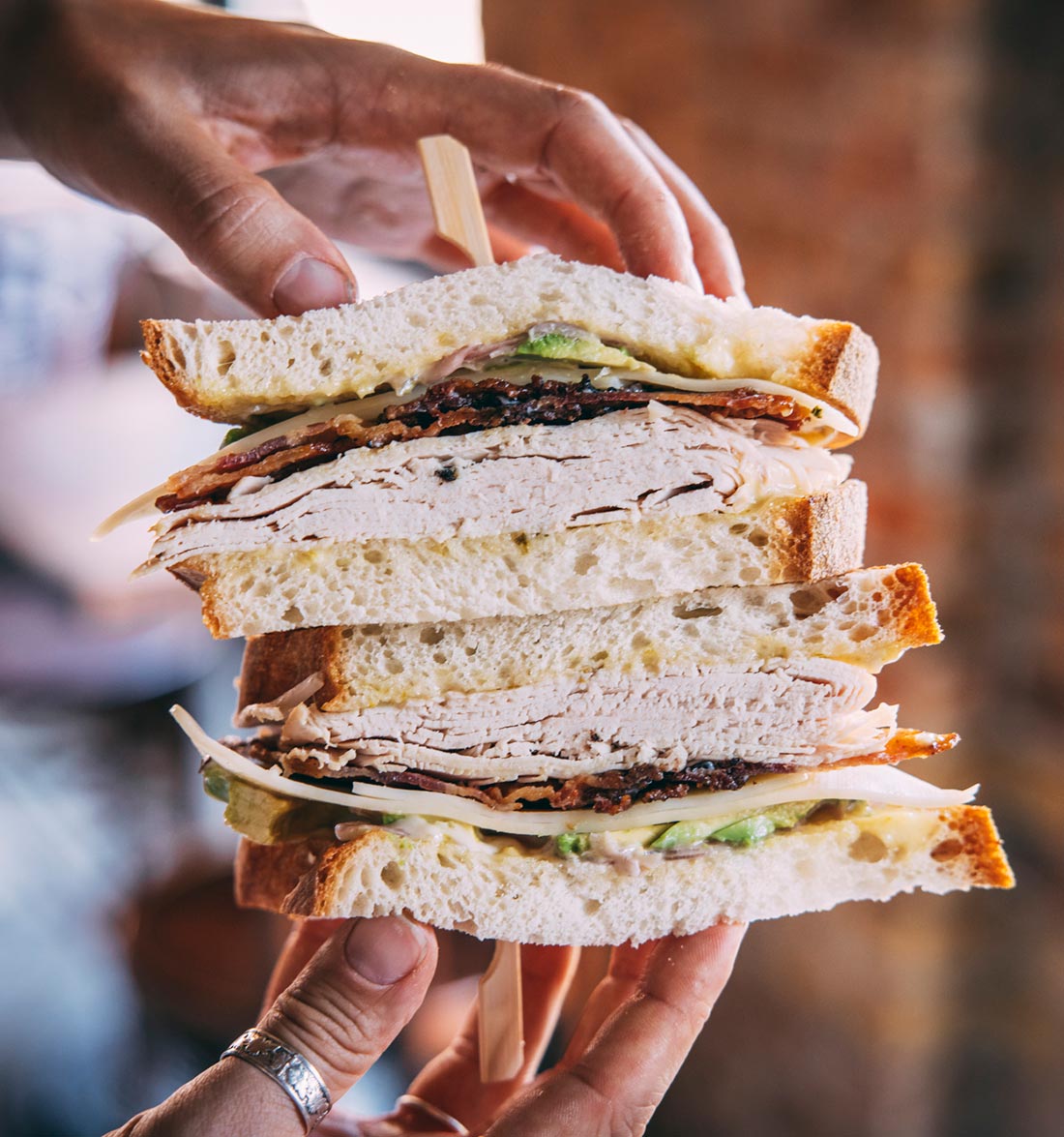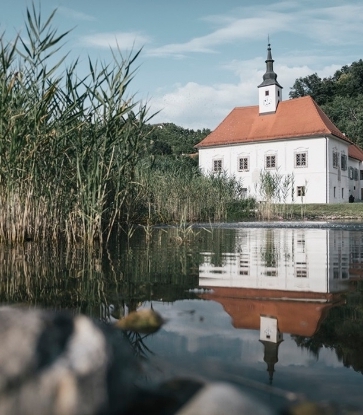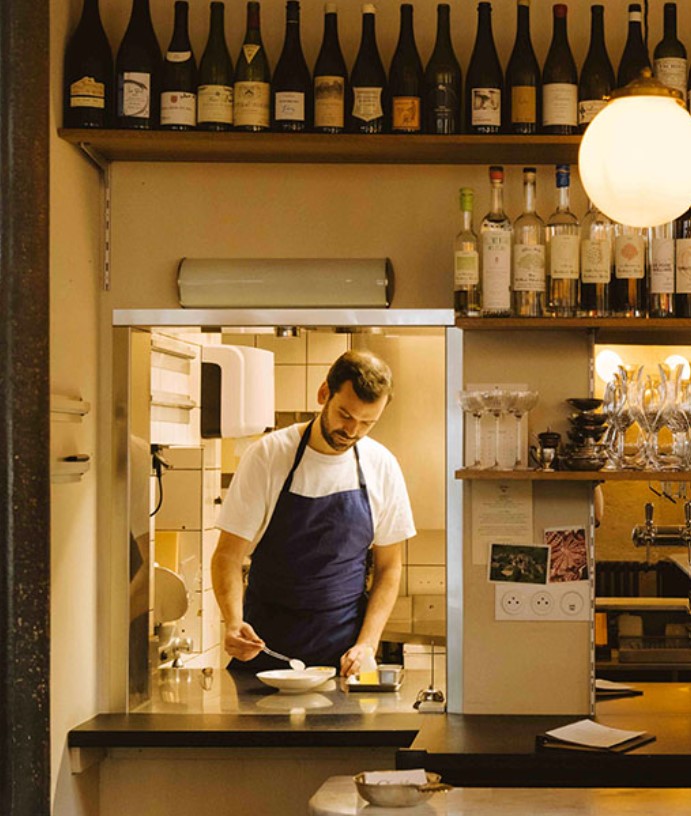Mediterranean Slovenia offers myriad gastronomic discoveries, with highlights such as the Sečovlje salt pans (which can be visited on foot), sea bass farms in Piran, truffles that grow on the hillsides overlooking the sea, persimmons, vines and other fruit that are all grown in the Karst region. In addition to these gastronomic delights, the region also boasts stunning architecture and beautiful scenery. The most emblematic example is Piran, an old port surrounded by medieval walls built during the period of Venetian influence – the town has retained its historic centre where narrow streets and tightly packed houses give it the air of an elegant, perfectly preserved seaside town. Let’s explore some of the places between Piran and the Istrian Slovenian coast where you can enjoy some of the region’s renowned culinary specialities.
Kogo
Despite being situated slightly outside the town, this restaurant in Koper has a convenient and easily accessible location. It boasts a young, dynamic and welcoming feel, with young chef Tilen Župevec in the kitchen, Peruvian Andy Polo front of house and Marko Kozel and Aljoša Mlinar, both from this coastal region yet with wide experience in restaurants further afield, running the operation as a whole.
The large dining room is minimalist, informal and elegant in style, there’s an extensive outdoor space, plus the option of dining in a private room, and the restaurant also works closely with the nearby Vinakoper winery. Guests come to Kogo for an aperitif, lunch or dinner and the food speaks for itself – the menu showcases local ingredients and recipes with a nod to contemporary trends and hints of French and Scandinavian influence in the elegant and carefully prepared cuisine. Tilen Župevec is young but determined – a self-taught chef who learned much of his craft in the field and online and who loves nature (he often goes foraging himself), plants and local produce. Vegetables are sourced from local farmers, fish from the nearby Adriatic of course, while the meat is Slovenian, as is the restaurant’s cured ham (with the exception of the San Daniele) and cheese.
The name of the restaurant speaks volumes – in Slovenian, Kogo means cook, an apt description for the culinary experience here. The à la carte menu is fixed, while lunch options change on a daily basis: the sliced meats include Cigoj bacon and Biosing bear salami, while the cheeses include Zidaric cheese produced on the Karst. Appetisers include pagar fish tartare marinated in herbs, carrots and citrus fruit and served with caviar and mustard seeds, as well as salted cod with dried black olive powder and olive oil, while main courses range from the fresh catch of the day to octopus in Malvasia wine and lamb roulade served with potatoes stuffed with smoked ricotta and herbs and a herb sauce.

Restavracija Hotela Marina
The Marina restaurant in Izola has been run for the past twenty years by chef Ivica Evačić-Ivek. The restaurant is part of a hotel that looks out towards the port where the town holds its cod festival every year in autumn. The menu has a seasonal focus and showcases a wide array of local ingredients, all of which are carefully chosen and of the highest quality.
Guests come here to enjoy raw langoustine from the Adriatic, buzara-style mussels, and polenta gratin with salted cod in a langoustine and fresh truffle cream, as well as sea bass in a salt crust with seasonal vegetables or beef carpaccio with Vremščica pecorino cheese. In addition to its seasonal dishes and fish specialities, Marina also offers a daily menu on which the chef demonstrates his creativity to the full.
The cuisine can be described as “from sea to plate” thanks to its wide choice of fish and seafood, which includes fresh oysters, raw seafood, clams, and fish stews and broths. Faithful to local traditions, the cuisine has for many years attracted guests from the hotel as well as locals and visitors from further afield who come to this stretch of coastline for their holidays, especially in summer.
Sophia
It is the elegance of bygone days that first strikes you when you enter the large dining room at the Sophia restaurant. The restaurant is situated in Portorož, within the Kempinski Palace that occupies one of the largest hotel buildings on this coast. The sea lies immediately in front of the hotel, so it’s no surprise that many of the dishes on the menu at this restaurant (named after the Italian film star Sophie Loren) feature fish and seafood.
Here, Istrian cuisine is accompanied by flavours influenced by France and other countries around the world. Self-taught chef Marjo Povsnar, whose past studies focused on economics and social anthropology, has been at the helm here for a decade. However, the hotel’s DNA almost runs in Povsnar’s blood, as his grandfather worked here before him. The restaurant menu changes three times a year and showcases an array of regional ingredients and recipes – the olive oil, butter and salt are all local (the Piran saltpans are just a few kilometres away), as are the fruit, vegetables, eggs and fish.
For example, the salmon comes from the nearby Rosandra valley and is served with a beetroot purée, fennel, dill sauce and buttermilk, while local persimmons are used to make a soup with carrot juice, salt, ginger, chilli pepper and Adriatic prawns. Influences from nearby Italy can be found in the pappardelle pasta with pheasant (the chef loves Tuscany), although the potato and barley soup is typically Slovenian. Main courses include umbrine fish with cauliflower, mandarin and pomegranate, and Rossini-style beef fillet served with foie gras and brioche.

Rizibizi
Patrizia and Tomaž Bevčič, the owners of Rizibizi who have run this restaurant since 2010, moved to Portorož beach just under three years ago. The restaurant has always been – and continues to be, even in its new location – renowned for its Istrian truffles, which are available throughout the year, thanks to the four different varieties used.
Served with meat or fish, this ingredient plays a leading role in the restaurant’s cuisine, which showcases the produce and traditions of the region. Dishes on the menu include Piran sea bass marinated in citrus fruit, sea bass carpaccio served with truffles, and truffle-based soups and home-made fuži pasta (the truffles available from November to February are the most sought-after).
Sustainability and zero-mile produce are the order of the day – the truffles are sourced directly from local truffle-hunters, the fish is local (85% from nearby Fonda, the only marine fish farm in Slovenia that breeds sea bass and mussels in an area of pristine water). Literally a stone’s throw from the sea, Rizibizi stands on the seafront promenade at Portorož where most of its large hotels are situated. The restaurant boasts an attractive dining room as well as a large outdoor space, while its impressive wine list features over 300 labels, 80% of which are Slovenian.

Stara Gostilna
A stone’s throw from Piran’s main square dedicated to the musician Giuseppe Tartini, Stara Gostilna (which means old inn in Slovenian) is a reliable dining option in town. Run by young and determined chef Kristian Zule who has plenty of experience in MICHELIN-starred restaurants at home and elsewhere in Europe, the restaurant boasts a welcoming outdoor space that leads into the charming main dining room of what is one of the oldest restaurants in Piran.
Hidden among the old houses in the historic centre, the restaurant, a small gem with views of the nearby Mediterranean, can seat up to twenty diners. Lobster, scampi, prawns and crab are among the ingredients served in dishes that showcase the region as well as others influenced by culinary traditions from around the world. The dish that perhaps best sums up the restaurant’s philosophy is a mosaic of local fish served on a plate that resembles rocks in the sea, on to which vegetables are delicately arranged – a nod to the chef’s future vision in which the restaurant has its own vegetable garden.
Careful attention is paid to the quality of the ingredients, as well as to presentation – note the ceramic tableware on which dishes are served, including items made by a local artist which depict the main square in Piran.

Hiša Torkla
Situated amid the Slovenian hills in the heart of Korte, this restaurant boasts large picture windows offering fine views of the surrounding meadows and natural landscapes for which Slovenia is famous. The restaurant is friendly and welcoming and often hosts groups of friends or families (especially on Sundays) who flock here for a day out to enjoy the peace of the countryside.
A large fireplace takes pride of place in the dining room, where the warm-toned walls are covered with photos. Since last spring, chef Gradimir Dimitric has been at the helm in the kitchen, bringing his culinary vision to this iconic restaurant, where he aims to surprise guests and attract visitors from the city and surrounding area. The menu changes with the seasons, with a focus on local ingredients (as well as produce from nearby Italy) and dishes cooked over the grill, such as meat roasted over the beechwood fire.
Specialities include duck breast marinated for two weeks in Refosco wine and served with duck crackling, beans, soy and Madeira sauce, as well as home-made fuži pasta served with white truffles or pumpkin oil and steak. Seafood dishes include raw Adriatic shrimp served with a lime and blueberry syrup and cod served with warm home-made bread and local olive oil.

Hero image: Dean Dubokovic-Sophia




















